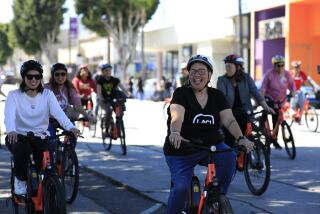A New Breed of Bike : Adventuresome Recumbent Cycle Enthusiasts Get Comfortable With Their Head-Turning Hobby
- Share via
Terry Pease zooms nearly effortlessly along the beach, his bike and body enveloped in a shimmering cocoon of yellow Spandex.
Heads turn, fingers point, people smile.
Pease, a 54-year-old Manhattan Beach resident, is the owner of a Lightning F-40, a new breed of bike so different from conventional bikes that he and other owners prefer to call them human-powered vehicles. That’s HPV to the initiated.
The Lightning is one of several brands of street bikes on which the rider eases into a cushiony seat that looks more like a La-Z-Boy lounge chair and reclines within easy reach of the ground. Hence the name, recumbent bike.
Enthusiasts with bucks can buy fluorescent-colored “fairings” that envelop the bike and biker. The stretchy nylon covering reduces wind resistance and protects bikers from sunburn or cold weather, Pease said.
In animated conversations, HPV owners let it drop that a racing model, the Gold Rush, was clocked at 65 m.p.h. on a 200-meter course. But the desire to race is not the reason most owners buy these bikes, Pease said. The appeal is comfort, safety and, for some, novelty.
Pease, an astronomer who worked at the Jet Propulsion Laboratory for 15 years, says going back to a conventional bike would be like going from a Jaguar or a Mercedes back to a horse-drawn carriage.
Pease said he got his first recumbent in 1985 and, a year later, he founded the South Bay Recumbent Riders club. There are no dues, and Pease, who is president, is not big on rules. The group meets once a month at Burton Chace Park in Marina del Rey (on the third Sunday at 10:30 a.m.) to swap bike stories, try out new bikes and share lunch.
The 52 members, who come from as far away as Oceanside and Newhall and as close as Santa Monica and Culver City, include a high school drafting teacher, a former beautician, a chiropractor, an architect and an artist.
Some have ridden recumbents for more than six years but others have ridden for only three months, yet most have stories to tell about the quizzical looks and strange reactions they get when they’re out on the streets and bike paths.
Reactions, the riders say, range from the unabashed excitement of schoolchildren, who will sometimes pour off a bus to just touch a recumbent bike, to derisive questions like “Why don’t you get a real bike?”
Recumbent riders insist, however, that these vehicles are not only real bikes, but better ones, and that the biggest difference from conventional bikes is comfort.
Riding a recumbent does not mean hunching over handlebars on small, hard seats. Thus, said Pease, there are no saddle sores and no aching shoulders and neck.
Pease thinks he should know. He puts in about 6,500 miles a year on his 18-speed recumbent.
Many riders insist that recumbents are superior to conventional bikes in every way. A few quiet dissenters say, however, that they don’t go uphill as well because the rider cannot stand on the pedals and use body weight to push. But what is lost going uphill is generally regained on the downhill or the flats because of the recumbent bike’s superior aerodynamics.
The bikes are not just for male techno-nerds, Pease insisted. Women enjoy them too.
Alyce Broome of Playa del Rey has been riding a recumbent for two years. She started shortly after her husband, Chris, bought a recumbent at a bike show and started riding with the club.
At first, Alyce Broome recalled, she would ride along on a conventional bike, but she soon noticed that at the end of a ride she hurt and her husband didn’t.
Club members got her to try one of the recumbents and her first reaction was “I have to have one of these.”
Broome now owns a 21-speed Presto Counterpoint made by a Seattle firm, and she and her husband put in 60 to 80 miles a week.
“We’d never go back to a conventional bike,” she said.
Linda and Mark Stone of Sherman Oaks got their flaming red Tour Easys as a wedding present from their family two years ago. The couple stopped off at the Tour Easy factory in Watsonville, Calif., on their way back from their honeymoon in San Francisco and paid $1,500 apiece for the bikes.
Riding a recumbent, Linda Stone said, “gives you a neat perspective of the world--comfortable and unhurried.”
Her husband added that the stretched-out frames of the Tour Easy reminds him of a Harley-Davidson chopper.
“I like the Harley connotation,” he said with a grin.
For some, the hobby has evolved into a vocation. Former beautician Milton Turner got hooked on riding recumbents more than a decade ago and soon began building them for himself. He and a friend got so hooked they would “compete against each other to see who could come up with the best design and the faster bike,” he said.
They decided to go commercial. Today, Turner Enterprises of Los Angeles turns out two models of what has been named the Laid Back bike: a basic machine for $700 and a premium model that is seven pounds lighter for $1,600.
Overall, according to Pease, recumbents range in price from $600 to $4,300.
It’s not cheap, but the rewards are great, said Mark Stone.
“We may never own a red Porsche or a red Ferrari, but we can own the world’s fastest red bike,” he said.
More to Read
Sign up for The Wild
We’ll help you find the best places to hike, bike and run, as well as the perfect silent spots for meditation and yoga.
You may occasionally receive promotional content from the Los Angeles Times.






